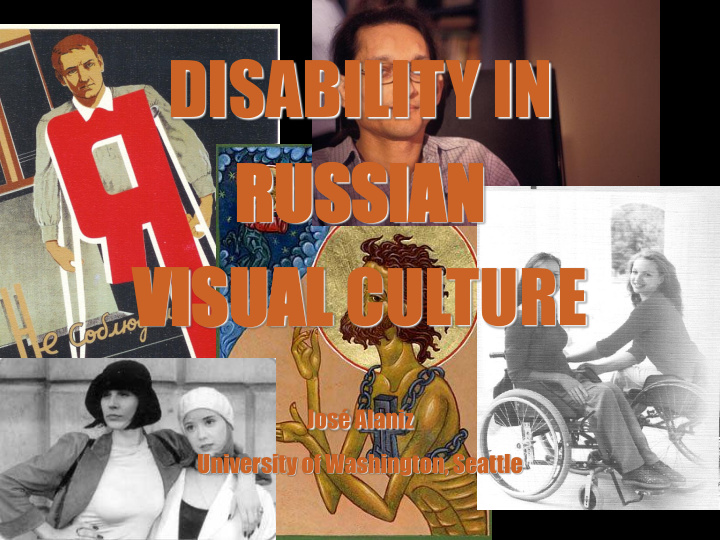



DISABILITY IN 5 RUS RUSSI SIAN AN VI VISUAL SUAL CULTURE José Alaniz University of Washington, Seattle
THE RUSSIAN ‘HOLY FOOL’ The age-old Russian tradition of the “Holy Fool” (юродивый) or “Fool for Christ” springs from St. Paul’s 1st Letter to the Corinthians 19: “The wisdom of this world is foolishness before God.” Divinely inspired hermits half-dressed in rags and chains, and permitted to violate social norms, the “holy fools” were at best tolerated by the Orthodox Church, but came to embody, especially after the 17th century, the purest form of the “Russian soul.” Icon of St. Basil, 15 th century
St. Basil’s Cathedral. Red Square, Moscow (1555 - 1561)
Mikhail Nesterov. The Spirit of the People, 1916-17. This famous patriotic painting, featuring luminaries from several centuries of Russian culture, places the holy fool in a central position – though still separate from the masses.
A modern-day icon of Saint Basil, a Holy Fool, 2004
Vasily Perov. The Blessed One, 1875-79. As Russia slowly modernized in the 19 th century, representations of the ‘holy fool’ took on a more secular tone.
Ilya Repin. Krestny Khod (Religious Procession) in Kursk Gubernia, 1880-1883. This painting, from an artistic movement called the Wanderers ( Передви ́ жники ) uses the image of the disabled to bring attention to social injustice in the Russian provinces.
THE LOVE-PITY ( ЛЮБОВЬ - ЖАЛОСТЬ) MODEL IN PRE-REVOLUTIONARY RUSSIAN CULTURE • The disabled are “God’s children” • They deserve pity, alms for their suffering • They carry the burden of all our sins • They will have their great reward in heaven • In the meantime …
THE BOLSHEVIK REVOLUTION, 1917 After the seizure of power by the Bolshevik faction, led by Vladimir Lenin, Russia became part of the new Soviet Union, the world’s first communist society, opposed to capitalism, religion, individualism and many other traditional values. Its treatment of the disabled emphasized their use to society and, within limits, provided for their welfare. “I did not follow the traffic rules.” Soviet propaganda poster, 1939.
Story of a Real Man ( Повесть о настоящем человеке , d. Alexander Stolper, 1948), tells the famous story of Alexei Maresyev, a legless WW II fighter pilot who refused to stay grounded after injury. He represented the “New Soviet Man,” whose heroic feats proved his superiority to capitalist models of masculinity.
Vadim Sidur’s sculptures, such as The Wounded Man ( Раненый , 1963) evinced a darker, more graphic view of wartime sacrifices.
THE POST- SOVIET ERA, 1991 With the break-up of the Soviet Union in 1991, Russia returned – ready or not – to full-blown capitalism. Hyper- inflation, the collapse of social services and poverty made life very difficult for the disabled, some of whom were reduced once more to begging in the streets. Moscow, early 1990s.
On the other hand, new possibilities opened up for the disabled in the 1990s, particularly in the area of human rights, as democracy struggled to gain a foothold in the new country. But despite events like this integrated marathon in the early 1990s, Russia’s disabled community remains largely excluded from mainstream society.
Lev Indolev, To Live in a Wheelchair, 2001
To greater and lesser degrees throughout Russia, the disabled are becoming more prominent in the culture. But there is still a long way to go. Academics and disability rights activists continue to press for more inclusion. Cover photo to Access to Higher Education for People with Disabilities: Problems and Perspectives, ed. D.V. Zaitseva, 2004
Arthouse films like Of Freaks and People ( Про уродов и людей, d. Alexei Balabanov, 1998) highlight the ‘spectacular’ aspects of the disabled body.
Films like the thriller/buddy movie Land of the Deaf ( Страна глухих, d. Valerii Todorovsky, 1998), meanwhile, continue to emphasize the “mystical” qualities of the disabled experience. In this film, the deaf character Yaya can “hear” things ordinary people can’t.
Less typical are films like A Driver for Vera ( Водитель для Веры , d. Pavel Chukhrai, 2004), which feature a disabled character (in this case a woman with a spinal deformity) without focusing on just that aspect.
Since 2000, the NGO Perspektiva (led by an American, Denise Roza), together with local organizations, has advocated for disability rights in Russia. In 2004 it launched a bi- annual film festival, Breaking Down Barriers (Кино без барьеров) , which showcases disability-themed works from throughout Russia, the former Soviet Union and the world.
Comics like those by the Christian Igor Kolgarev’s “He is With Us” ( Amen Comics, 2005), retain a traditional view of the disabled as worthy of love-pity and, in a sense, closer to God. In this story, disability is a problem to be healed through steadfast faith.
A 2006 comics adaptation of Story About a Real Man (art by Yevgeny Gusev) once more portrays Maresev’s story as one of heroic, manly overcoming and patriotic fervor.
Tatyana Faskhutdinova. Unknown Stories from the Life of Lyonya Rodin, 2012
Recommend
More recommend